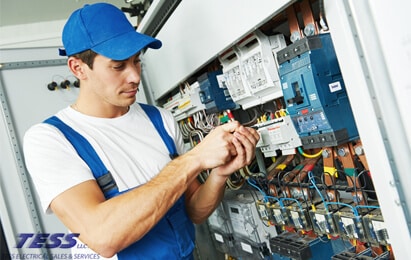
Regardless of how complex a yacht’s electrical system is, or how many independent electrical devices are wired to it, boats will never be the ideal environment for an electrical system. Between saltwater, wind, rain, vibrations, pounding, heat and any of the other elements the electrical system is exposed to, a lot of pressure and erosion is put on the wires and circuits over time. From a safety standpoint, more than 55 percent of fires on board boats that were investigated by BoatU.S. were found to have been caused by wiring and electrical problems (with wire chafing found as the most common problem). In between your regularly scheduled annual, bi-annual or other scheduled electrical audits, here are some additional things you can perform more regularly to maintain proper electrical health and safety on your yacht.
1. Have A Basic Understanding of Your Boats Electrical System
To start, it’s important that as someone responsible for the health and safety of not only your boat, but also the people that are onboard your boat, that you have a basic understanding of the onboard systems that help it function. Now this is not to say that you should be able to identify, diagnose and resolve any and every situation that can arise within your boats electrical system, however you should be able to identify if and when devices or systems are not functioning at full capacity, not functioning as expected, or there are any other abnormal conditions surrounding a piece of equipment or anywhere on your boat. For example, if a panel in your boats cockpit is abnormally warm, this can indicate that a wire or circuit is giving off too much heat or that another piece of equipment is working too hard to perform it’s standard operation. Both of these scenarios can lead to greater problems down the road, but being able to quickly identify potential problems and engage a professional who is equipped to identify and resolve your issues is the first line of defense for any yacht or boat owner.
2. Pay Attention To Any New Significant Sounds Or Vibrations You May Experience
Whether you are out on the water or in the dock, your boat is at full speed or at a total standstill, be cognizant for any new sounds, vibrations, changes in heat or noticeable changes in your boats operation. Being aware of and acting on these changes will allow you to avoid potential problems like vibrations leading to wire chafing which as we mentioned earlier is the leading cause of onboard fires. As every boat is different, this also gives you the opportunity to identify smaller, less threatening changes in your boats operation and monitor them over time to give you a better baseline for serious issues going forward. The more closely you become accustomed to your boats behaviors or “personality” the more easily you’ll be able to identify any potential problems.
3. Have A Regular Routine For Visual Inspections
Work with your marine electrician to create a basic routine for visual inspections. Depending on the size of your boat, the tools you have at hand, and the equipment and electronics you have on board, this can change from boat to boat, however they should all cover the same basic areas. Primarily, you should be looking for anything exposed, corroded, or deteriorating wires, any wires that are now visible that were not previously, any equipment or machinery that is giving off too much heat or using too much power, any signs of water damage or weathering especially near electrical equipment, any shortages in any of your yacht electrical systems, and if possible run thermal testing to see if any parts of the boat that are unable to be seen are giving off too much heat. These routine visual inspections are not intended to replace any more significant audits or testing done by your professional yacht electrician, however these inspections should simply be part of your regular routine when using your boat.
4. Regularly Run Your Pumps And Pay Attention For Anything Unusual
In addition to running visual tests of your boat, it’s also important to regularly test the on board equipment, which of course includes your boats various pumps. Due to the nature of where pumps are placed and their primary functionality, they are of course susceptible to deterioration and general erosion which can lead to things like overuse of power, pumps overheating, and in some cases circuits being shorted or even fires. Make sure to regularly run your pumps to not only test that they are fully operational but to also watch and listen for anything out of the ordinary that may indicate a problem to come. These simple tests can save you a lot of the time, headache and money involved in having to replace pumps.
5. Make Sure To Schedule Routine Maintenance With Your Yacht Electrician
Most importantly, it is imperative that you work with a trusted yacht electrician to not only perform an initial audit and inspection on your boat when you first purchase it, but to also develop a comprehensive audit tailored to it’s needs as well as a schedule for this audit to be regularly performed. Most boats will typically schedule these routine inspections to be once or twice per year, but depending on the size of the boat, the complexity of it’s equipment, as well as how and how often it’s being used it may mean that a more regular inspection schedule is appropriate. To schedule one of our experienced yacht electricians to perform a comprehensive audit on your yacht or boat and develop a schedule for routine yacht inspection, please reach out to one of our experienced team members.







